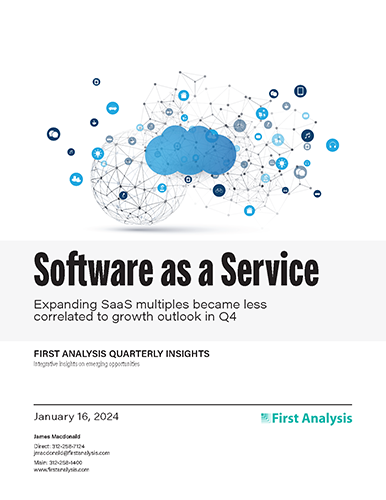Quarterly insights: Software as a Service
Expanding SaaS multiples became less correlated to growth outlook in Q4

Our SaaS universe gained 16.0% on average in the December quarter. The cybersecurity and data visibility groups continued to be the leading gainers.
The SaaS average enterprise value multiple of 2023 estimated revenue increased to 7.8 from 6.6 last quarter. For 2024, the average multiple was 6.7, up from 5.6 last quarter despite an expected slowdown in growth to 13.3% from 15.8% last quarter.
Correlations between revenue multiples and revenue growth expectations, which were already low by our historical measures, declined from the September quarter, suggesting the valuation gains in the quarter were based on factors other than fundamental growth prospects; we believe momentum was a big factor.
TABLE OF CONTENTS
Includes discussion of six private companies
- Overview of our analysis
- “Go-to-market” software group newly broken out in our universe
- Signs of life in M&A
- Revenue multiples expand; correlation to growth declines
- Cybersecurity and data visibility again lead stock price gains in quarter
- SaaS M&A: Notable transactions include Parchment and Talon Cyber Security
- SaaS private placements: Notable transactions include AssemblyAI, Cart.com
Overview of our analysis
Our SaaS universe gained 16.0% on average in the December quarter, beating the S&P 500’s 11.2% gain. Twenty-five stocks (25.5% of our universe) gained over 30% in the quarter. Only four SaaS stocks (4.1%) declined by more than 20% in the quarter. The SaaS average enterprise value multiple of 2023 estimated revenue increased to 7.8 from 6.6 last quarter. For 2024, the average multiple was 6.7, up from 5.6 last quarter despite an expected slowdown in growth to 13.3% (from 15.8% last quarter). Correlations between multiples and revenue growth expectations, which were already low by our historical measures, declined from the September quarter.
The five largest-capitalization names we discussed last quarter – Salesforce (CRM), ServiceNow (NOW), Shopify (SHOP), Snowflake (SNOW) and Workday (WDAY) – all participated in the strength, gaining 26.4% to 42.8%. The cybersecurity and data visibility groups continued to be the leading gainers, with the cybersecurity group up 33.3% on average and the data visibility group up 27.4% on average; neither saw any acquisition activity in the quarter. The future of work group was the worst performer, gaining only 2.2% on average in the quarter.

Request full report
To access the full report, please provide your contact information in the form below. Thank you for your interest in First Analysis research.
